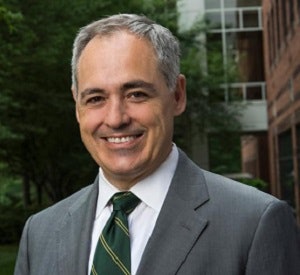For over a third of American undergraduate students, pursuit of a college education begins at community college.
These students are more likely than other undergraduates to come from lower-income families, to be people of color, and to work or raise children while in school. Many are the first in their families to attend college. They have enrolled because the practical and economic realities of their lives have shown them that they need a higher education to get ahead, to fulfill their potential and ambitions. And a community college is often the best available option.
Excellent community colleges propel students of all backgrounds into the middle class. Some community college alumni transfer to a four-year university and go on to become teachers and engineers, doctors, lawyers and business leaders. Others go straight from community college to work, becoming the nurses, advanced manufacturing technicians and engine mechanics who make our communities run.
 Dr. Ángel Cabrera
Dr. Ángel CabreraThese community colleges offer students an affordable path, enabling their graduates to emerge without the student debt that has ballooned in our country – to more than $1.5 trillion. It’s time that we celebrate the enormous value provided by high-quality community colleges, just as loudly as we laud “elite” colleges and universities.
We should know. As an executive of a major American corporation and a president of a university whose student body is half community college graduates, we see what employers are looking for in recent graduates. As members of the jury that recently selected the winners of the $1-million Aspen Prize for Community College Excellence — Florida’s Miami Dade College and Indian River State College — we have seen what great community colleges can look like, especially for nontraditional students.
How do these colleges provide value to students?
First, their students complete college or transfer to four-year schools at rates that far surpass the national average. This matters. Americans with a college degree earn, on average, nearly $1 million more over their lifetime than those who achieve no more than a high school diploma. And they are far more likely to be able to repay the student debt that so many presidential candidates are talking about.
 Joelle Phillips
Joelle PhillipsSecond, these colleges make sure that students of color and low-income students actually obtain the credentials they seek. Being an excellent community college (or, for that matter, an excellent four-year college) means closing the persistent gaps in college-degree attainment that rob our communities, employers and our economy of needed talent. At both Miami Dade College and Indian River State College, students of color complete their degrees at rates considerably higher than the national average for all students, and Miami Dade has eliminated the completion gap entirely.
Third, these colleges take responsibility for what happens to students after they graduate. The two Aspen Prize-winning colleges achieve excellent outcomes for graduates after transfer to four-year schools and in the labor market. The average salary of recent graduates exceeds that for all new hires in their regions, no matter their education level.
Community colleges offer a low-cost education, and they accept everyone. As a result, they can deliver broad economic value. But more community colleges need to follow the lead of the Aspen Prize winners to deliver value to students who are investing not just tuition dollars, but years of their time to get ahead.
All of us benefit when community colleges achieve excellent student outcomes. In an era of very low unemployment, companies still struggle to find qualified workers in many fields that community college students are trained in, such as health care and information technology. Today, four in five community college students aim to transfer and earn a bachelor’s degree, but only 16 percent do so within six years. Imagine the economic benefit we would reap if all students who aspired to that degree attained it.
So, let’s learn from Aspen Prize-winning Miami Dade and Indian River, colleges that excel compared to their peers. These are the low-cost, diverse centers of learning that are preparing our future workforce. By opening their doors to all, they embody our democratic ideals and provide a realistic path toward the American dream. Their graduates are our future, and they provide the value that all college students need. Let’s celebrate them. And let’s strive to make sure that community college students everywhere can experience such excellence.
Dr. Ángel Cabrera, president of George Mason University, will be the next president of the Georgia Institute of Technology and co-chaired the jury that picked the winners of the 2019 Aspen Prize. Joelle Phillips is president of AT&T Tennessee and was a jury member.















